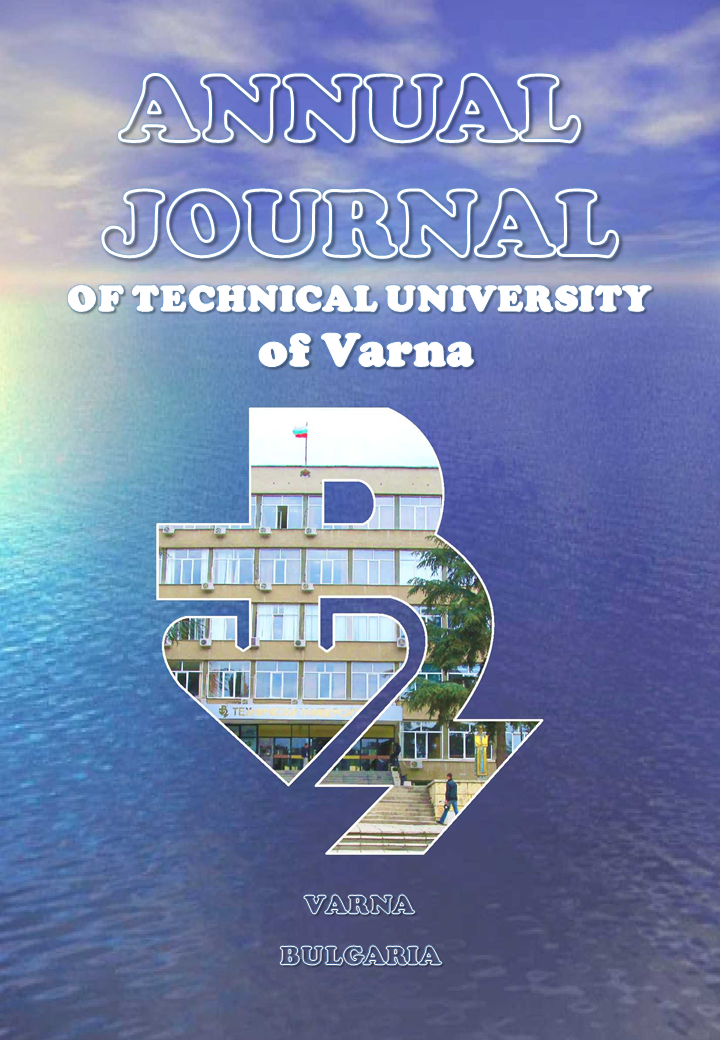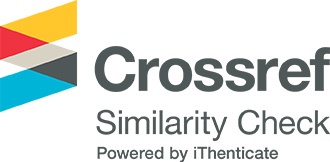Drone-based Monitoring of Sunflower Crops
##semicolon##
https://doi.org/10.29114/ajtuv.vol6.iss1.258##semicolon##
agricultural monitoring, infrared imaging, sunflower, vegetation indexes, drone##common.commaListSeparator## agricultural monitoring##common.commaListSeparator## infrared imaging##common.commaListSeparator## sunflower##common.commaListSeparator## vegetation indexes##common.commaListSeparator## droneАбстракт
Remote monitoring and utilization of digital technologies is essential for the application of the precision farming approach, which contributes significantly to the improved quality of agricultural products. The paper compares the data for six vegetation indices when observing the sunflower vegetation in South Dobrudzha in 2021. Images with RGB and digital NIR camera were obtained via a remotely piloted quadcopter. The flight plan specifies speed 8 m/s, altitude 100 m and shooting overlapping images of 80%. Six vegetation indices: NDVI, EVI2, SAVI, CVI, MGVRI and MPRI were calculated from the images obtained during the flight. The calculation of the indices takes into account the intensity of solar radiation and the parameters of the meteorological situation at the time of shooting. The findings obtained reveal a stable trend of change of the vegetation indices, thus, establishing accurate and reliable results as for the monitoring of agricultural areas with unmanned aerial vehicles.
Изтегляния
##submission.citations##
<p> Bannari, A., Morin, D., Huete, A.R. & Bonn, F. (1995). Our view of vegetation indices. <em>Remote Sensing Reviews, 13</em>(1-2)<em>,</em> 95-120. <u><a href="https://doi.org/10.1080/02757259509532298">https://doi.org/10.1080/02757259509532298</a></u></p>
<p> Bendig, J., Yu, K., Aasen, H., Bolten, A., Bennertz, S., Broscheit, J. & Bareth, G. (2015). Combining UAV-based plant height from crop surface models, visible, and near infrared vegetation indices for biomass monitoring in barley. <em>International Journal of Applied Earth Observation and Geoinformation</em>, <em>39</em>, 79-87. <u><a href="https://doi.org/10.1016/j.jag.2015.02.012">https://doi.org/10.1016/j.jag.2015.02.012</a></u></p>
<p> Burgess, D. W., Lewis, P., & Muller, J.-P.A.L. (1995). Topographic Effects in AVHRR NDVI Data. <em>Remote Sensing of Environment</em>, <em>54</em>, 223-232. <u><a href="https://doi.org/10.1016/0034-4257(95)00155-7">https://doi.org/10.1016/0034-4257(95)00155-7</a></u></p>
<p> Huete, A. R. (1988). A soil-adjusted vegetation index (SAVI). <em>Remote Sensing of Environment</em>, <em>25</em>, 295-309. <u><a href="https://doi.org/10.1016/0034-4257(88)90106-X">https://doi.org/10.1016/0034-4257(88)90106-X</a></u></p>
<p> Myneni, R.B. & Asrar, G. (1994). Atmospheric Effects and Spectral Vegetation Indices. <em>Remote Sensing of Environment</em>, <em>17</em>, 390-402. <u><a href="https://doi.org/10.1016/0034-4257(94)90106-6">https://doi.org/10.1016/0034-4257(94)90106-6</a></u></p>
<p> Mihaylov, R. (2019). Using drones to track development of maize cultivation. <em>Farm machinery and Processes Management in sustainable Agriculture, Machinery Equipment, Lublin, Poland</em> <em>2019</em>, 43-48. <u><a href="https://doi.org/10.24326/fmpmsa.2019.1">https://doi.org/10.24326/fmpmsa.2019.1</a></u></p>
<p> Mihaylov, R., Atanasov, A., Ivanova, A., & Mihaylova, D. (2020). Study of the vegetation of spring crops in the region of South Dobrudhza in 2020. <em>Annual Journal of Technical University of Varna (AJTUV)</em>, <em>4</em>(2),122-129. <u><a href="https://doi.org/10.29114/ajtuv.vol4.iss2.203">https://doi.org/10.29114/ajtuv.vol4.iss2.203</a></u></p>
<p>Mihajlow, R., & Ivanova, A. (2019). Drone video capture - a new method in precision agriculture. <em>Annual Journal of Technical University of Varna (AJTUV), 3</em>(2) <u><a href="https://doi.org/10.29114/ajtuv.vol3.iss2.141">https://doi.org/10.29114/ajtuv.vol3.iss2.141</a></u></p>
<p>Rouse, J. W., Haas, R. H., Schell, J. A., Deering, D. W., & Harlan, J. C. (1974). <em>Monitoring the vernal advancement of retrogradation of natural vegetation, </em>p. 371. Greenbelt, MD: NASA/GSFC (Type III, Final Report).</p>
<p> Sankaran, S., Khot, L. R., Espinoza, C. Z., Jarolmasjed, S., Sathuvalli, V. R., Vandemark, G. J., et al. (2015). Low-altitude, high-resolution aerial imaging systems for row and field crop phenotyping: a review. <em>Eur. J. Agron.</em>, <em>70</em>, 112-123. <u><a href="https://doi.org/10.1016/j.eja.2015.07.004">https://doi.org/10.1016/j.eja.2015.07.004</a></u></p>
<p> Shi, Y., Thomasson, J. A., Murray, S. C., Pugh, N. A., Rooney, W. L., Shafian, S., et al. (2016). Unmanned aerial vehicles for high-throughput phenotyping and agronomic research. <em>PLoS One, 11</em>(7) Article e0159781. <u><a href="https://doi.org/10.1371/journal.pone.0159781">https://doi.org/10.1371/journal.pone.0159781</a></u></p>
<p> Teillet, P.M., Staenz, K. & Williams, D.J. (1997). Effects of spectral, spatial, and radiometric characteristics on remote sensing vegetation indices of forested regions. <em>Remote Sensing of Environment, 61</em>, 139-149. <u><a href="https://doi.org/10.1016/S0034-4257(96)00248-9">https://doi.org/10.1016/S0034-4257(96)00248-9</a></u></p>
<p>Vincini M., Frazzi, E. & D' Alessio, P. (2008). A broad-band leaf chlorophyll vegetation index at the canopy scale. <em>Precision Agric, 9</em>, 303–319. <u><a href="https://doi.org/10.1007/s11119-008-9075-z">https://doi.org/10.1007/s11119-008-9075-z</a></u></p>
<p>Yang, Z., Willis, P. & Mueller, R. (2008). <em>Impact of band-ratio enhanced AWIFS image to crop classification accuracy</em>. Pecora 17, 18-20. Department of Health and Ageing. (2012). Aboriginal and Torres Strait Islander health performance framework 2012 report.</p>
<p> Yang, G., Liu, J., Zhao, C., Li, Z., Huang, Y., Yu, H., et al. (2017). Unmanned aerial vehicle remote sensing for field-based crop phenotyping: current status and Perspectives. <em>Front. Plant Sci.</em>, <em>8</em>, <u><a href="https://doi.org/10.3389/fpls.2017.01111">https://doi.org/10.3389/fpls.2017.01111</a></u></p>
<p> Watson, D.J. (1947). Comparative physiological studies on the growth of field crops: I. Variation in net assimilation rate and leaf area between species and varieties and within and between years. <em>Annals of Botany., 11,</em> 41-76. <u><a href="https://doi.org/10.1093/oxfordjournals.aob.a083148">https://doi.org/10.1093/oxfordjournals.aob.a083148</a></u></p>
<p> Zhangyan J., Alfredo R.H., Kamel D., & Tomoaki M. (2008). Development of a two-band enhanced vegetation index without a blue band. <em>Remote Sensing of Environment, 112</em> (10), 3833-3845. <u><a href="https://doi.org/10.1016/j.rse.2008.06.006">https://doi.org/10.1016/j.rse.2008.06.006</a></u></p>
##submission.downloads##
Публикуван
##submission.howToCite##
Брой
Раздел (Секция)
##submission.license##
СПОРАЗУМЕНИЕ ЗА ПУБЛИКУВАНЕ
Годишника на Технически университет - Варна (ГТУВ) цели да гарантира, че постъпващите статии се публикуват, като същевременно се предоставя значителна свобода на публикуващите ги автори. За изпълнение на тази цел, ГТУВ поддържа гъвкава политика относно авторските права, което означава, че няма прехвърляне на авторски права от автора на издателя, а авторите запазват изключително авторско право върху интелектуалното си произведение.
При изпращане на статия, Отговорния автор трябва да се съгласи и приеме правилата и условията за публикуване, изложени в настоящото Споразумение за публикуване, които са както следва:
ПРЕДОСТАВЯНЕ НА ПРАВА ОТ ОТГОВОРНИЯ АВТОР
Отговорния автор предоставя на ГТУВ за времето на пълния срок на авторското право и всяко следващо удължаване или подновяване, следното:
• Неотменимо, неизключително право да публикува, възпроизвежда, предоставя, разпространява или по друг начин използва предоставената работа в електронни и печатни издания и в производни произведения в целия свят, на всички езици и във всички известни съществуващи или в последствие възникнали медии.
• Неотменимо, неизключително право да създава и съхранява електронни архивни копия на работата, включително правото да депозира предоставената работа в дигитални хранилища с отворен достъп.
• Неотменимо, неизключително право на лицензиране на други лица да възпроизвеждат, превеждат, преиздават, предоставят и разпространяват предоставената работа при условие, че авторите са надлежно идентифицирани (за момента това се извършва чрез публикуване на произведението под лиценз Creative Commons Attribution 4.0 Unported).
С предоставянето на работата за публикуване, авторските права върху материала остават на авторите. Авторите запазват всички патентни, търговски марки и/или други права върху интелектуалната си собственост.
ЗАДЪЛЖЕНИЯ НА ОТГОВОРНИЯ АВТОР И СЪАВТОРИТЕ
При последващо разпространение или повторно публикуване на предоставената работа, Отговорния автор се съгласява да идентифицира ГТУВ, в който е публикувано произведението като първоначален източник на първото публикуване на работата. Отговорния автор гарантира, че съавторите също ще посочват ГТУВ като източник на първото публикуване, когато разпространяват, преиздават или се позовават на настоящата работа в бъдещи свои публикации.
ГАРАНЦИИ ОТ СТРАНА НА ОТГОВОРНИЯ АВТОР
Отговорния автор гарантира че предоставената за публикуване работа не нарушава никои действащи нормативни разпоредби или законни права на която и да е трета страна. Същия гарантира че работата не съдържа какъвто и да е материал, който може да се възприеме от читателската аудитория като неетичен, компрометиращ, нехуманен, расистки, клеветнически и/или нарушаващ авторски и/или имуществени права, права на интелектуална собственост или поети ангажименти за поверителност към трети страни. Отговорния автор гарантира че предоставеният материал е с оригинално съдържание, не е официално публикуван в никое друго издателство, както и че не е в процес на публикуване пред други издателства. Отговорния автор също така гарантира че притежава съответните правомощия да сключи настоящото споразумение. Ако предоставяната работа е подготвена съвместно с други съавтори, Отговорния автор гарантира че всички останали съавтори са информирани и са съгласни предоставения материал да бъде публикуван в ГТУВ.
Отговорния автор лично (или от името на авторския колектив) дава съгласието си да не въвлича по никакъв начин ГТУВ като страна в каквито и да било научни, академични, административни и/или съдебни спорове, в случаите на установени нарушения на горепосочените декларации и гаранции.
ПРАВА И ЗАДЪЛЖЕНИЯ НА ГТУВ
ГТУВ се съгласява да публикува предоставения материал, в случаите когато същия отговаря напълно на всички необходими качествени, технически и редакционни изисквания, като го идентифицира еднозначно с авторите му. В следствие на настоящото споразумение, на ГТУВ се предоставя правомощие да упражнява права при необходимост от името на авторите върху трети лица, като например в случаите на установено плагиатство, нарушаване на авторски права и др.
Декларация за поверителност на лични данни
Вашите имена и имейл адреси, въведени в уебсайта на ГТУВ, ще бъдат използвани само и изключително за обявените цели на настоящото списание и няма да бъдат използвани за никакви други цели от издателя или предоставяни на друга - трета страна.
Издателят се задължава да извърши всички необходими действия, цялата предоставена лична информация да остане конфиденциална, в рамките на издателя и да не бъде споделена с външни обекти или субекти, освен ако не е дадено предварително изрично разрешение от собственика на личните данни.
Вашата лична информация няма да бъде обект на продажба, разпространение или публикуване по какъвто и да е начин и под каквато и да е форма.









